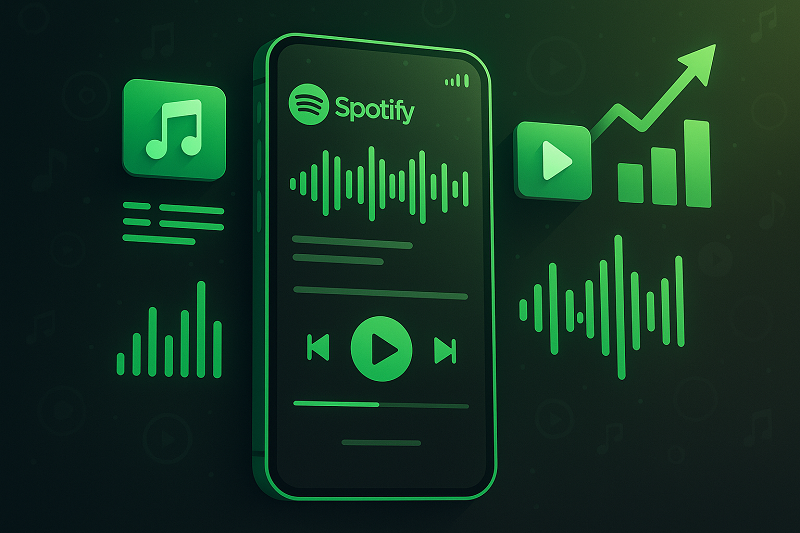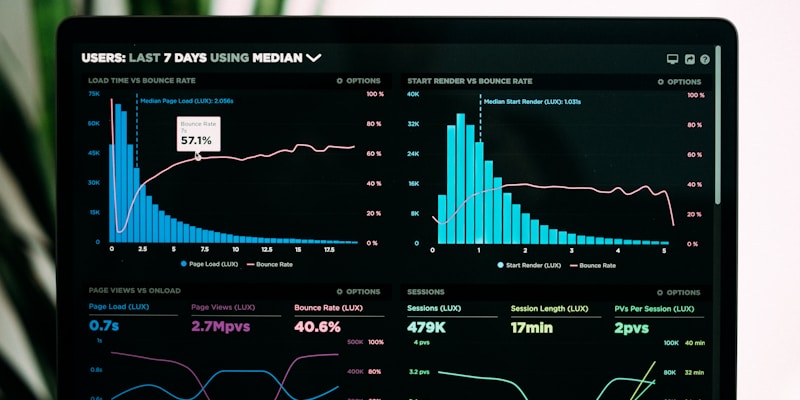Picture this: Sarah, an independent singer-songwriter from Nashville, had been uploading her music to Spotify for two years with barely 500 monthly listeners. She was doing everything she thought was right—posting regularly, sharing on social media, even paying for some playlist placements.
Then, in just six months, everything changed. Her monthly listeners jumped to over 50,000, she landed on three major editorial playlists, and her latest single hit 2 million streams.
What changed? She discovered the strategies that actually work in 2025’s competitive music landscape.
With over 120,000 new songs uploaded to Spotify daily and algorithm changes constantly reshaping how music gets discovered, success requires more than just great music. Whether you’re an emerging artist seeking your first breakthrough or a content creator needing flexible access to your music collection, this guide reveals the proven strategies that separate successful artists from those still struggling to be heard.
In This Article:
Understanding Spotify’s Ecosystem in 2025
The Current State of Music Discovery
The music streaming landscape has undergone dramatic changes in 2025. With Spotify’s 675 million monthly active users consuming content at an ever-increasing rate, the platform has become the primary gateway for music discovery worldwide.
But here’s the kicker: approximately 120,000 new songs are uploaded to streaming platforms like Spotify every single day. That’s insane competition.
The algorithm has also evolved significantly. It now prioritizes engagement metrics over simple play counts. Songs with higher save rates, lower skip rates, and stronger listener retention have better chances of being featured in algorithmic playlists like Discover Weekly and Release Radar.
Why Traditional Promotion Methods Fall Short
Many artists still rely on outdated promotion strategies that worked in Spotify’s earlier years but have become ineffective in 2025. The most common misconception? Paying for playlist placements guarantees success.
Trust me, it doesn’t.
Reddit discussions from r/WeAreTheMusicMakers consistently highlight artists who spent hundreds of dollars on playlist services only to see minimal engagement and no lasting growth. The reality is that algorithmic playlists now drive more discovery than editorial ones for most independent artists.
Another failing strategy is the “spray and pray” approach to playlist submissions. Artists who submit to hundreds of playlists without researching curator preferences often see their music ignored or quickly removed.
The most successful artists in 2025 focus on building genuine relationships with curators who genuinely appreciate their musical style.
Profile Optimization: Your Foundation for Success
Creating a Professional Artist Presence
Your Spotify artist profile serves as your digital storefront. First impressions matter more than ever in 2025’s crowded marketplace.
Research from music industry analytics shows that profiles with professional human photos receive 40% more engagement than those using logos or abstract artwork. This psychological principle stems from humans’ natural tendency to connect with faces rather than brands.
The Face vs Logo Strategy
When playlist curators and potential fans visit your profile, they’re making split-second decisions about whether to invest their time in your music. A clear, friendly photo of yourself creates immediate trust and relatability.
For your profile photo, use a high-resolution image with good lighting that clearly shows your face. Avoid overly filtered or heavily edited photos that might appear inauthentic.
Crafting Compelling Artist Bios
Your artist bio should follow a proven three-part structure:
- Origin – Your musical background, influences, or the moment you knew music was your calling
- Journey – Key milestones, collaborations, or achievements that demonstrate your growth
- Future – What you’re working on next, your goals, or the impact you want to make
This doesn’t need to include major label deals or Grammy nominations. Even local performances, viral social media moments, or meaningful fan interactions can showcase your dedication and progress.
Activity and Engagement Tracking
Adding Gig Information for Credibility
Live performance listings significantly boost your profile’s credibility and algorithmic trust. Spotify’s algorithm considers artist activity as a ranking factor, and regular gig updates signal that you’re an active, professional musician.
Use Bands in Town integration to automatically sync your upcoming shows with your Spotify profile. Whether you’re performing at Madison Square Garden or your local coffee shop, each listing adds to your professional credibility.
Regular Profile Updates and Maintenance
Successful artists treat their Spotify profiles like living documents that require regular attention. Implement a monthly optimization routine that includes:
- Updating your bio with recent achievements
- Refreshing your “Artist Pick” to highlight new releases
- Ensuring all links direct to active, relevant content
The “Artist Pick” feature deserves special attention as it’s the first thing visitors see on your profile. Use this space strategically to promote your latest release, an important playlist placement, or upcoming shows.
Mastering Playlist Strategies in 2025
Editorial Playlist Submission Tactics
Timing Your Submissions for Maximum Impact
The most critical mistake artists make with editorial playlist submissions is timing. Spotify’s editorial team requires submissions at least 7 days before your release date, but industry insiders recommend submitting even earlier when possible.
Here’s the deal: submissions made 2-3 weeks in advance have 300% higher acceptance rates than last-minute submissions.
This early submission window allows editorial curators adequate time to review your track, consider it for multiple playlists, and plan their upcoming playlist updates. Remember that these curators receive thousands of submissions weekly.
When you receive the submission notification from Spotify for Artists, act immediately. Have your pitch prepared in advance, including key details about your song’s story, any notable achievements, and specific editorial playlists you’re targeting.
Understanding Editorial vs Algorithmic Playlists
Editorial playlists, identifiable by the official Spotify logo next to the curator’s name, offer prestige and significant reach but have extremely competitive acceptance rates.
Algorithmic playlists like Discover Weekly, Release Radar, and Daily Mix operate differently. They use machine learning to match songs with listeners based on their listening history and preferences. While you can’t directly submit to these playlists, you can influence your chances of inclusion through strategic engagement optimization.
The key difference? Editorial playlists provide immediate, massive exposure but may not guarantee long-term engagement. Algorithmic playlists typically offer more sustained, targeted exposure to listeners who are genuinely likely to enjoy your music.
Building User Playlist Networks
Creating Curated Playlists That Convert
User-generated playlists have become increasingly powerful for music discovery, with 36% of listening time spent on these community-created collections. The optimal playlist length falls between 20-60 songs, providing enough variety to keep listeners engaged without becoming overwhelming.
Update your playlists at least weekly to maintain freshness and encourage followers to return regularly. Include 2-3 of your own tracks strategically placed throughout the playlist—not clustered together, which appears self-promotional, but naturally integrated with complementary songs from other artists.
Theme your playlists around specific moods, activities, or genres rather than simply featuring your music. Examples include “Late Night Study Sessions,” “Road Trip Anthems,” or “Indie Folk for Rainy Days.”
Community Engagement Strategies
Building relationships with other artists and playlist curators requires genuine engagement rather than transactional interactions. When you discover songs you genuinely enjoy, add them to your playlists and send a brief, authentic message to the artist expressing your appreciation.
Avoid generic messages like “Great track, please check out my music.” Instead, be specific about what you enjoyed: “The guitar work in your latest single reminds me of early Kings of Leon—added it to my indie rock playlist.”
This specificity shows you actually listened and creates a foundation for meaningful connection.
Paid vs Organic Growth Approaches
Understanding Paid Playlist Limitations
The playlist promotion industry has become increasingly problematic. Many services promise unrealistic results or use questionable methods that can harm your Spotify profile.
The most significant issue is genre mismatch—when your indie folk song gets placed on a hip-hop playlist with millions of followers, the resulting skips and lack of engagement actually hurt your algorithmic performance.
Spotify’s 2024 policy changes redistributed $40 million from tracks with fewer than 1,000 streams to those with more, making artificial inflation even more counterproductive.
Organic Growth Alternatives That Actually Work
The most sustainable growth comes from targeting niche playlists with genuinely engaged audiences. Use tools like Chartmetric and Spot on Track to research playlist curators who regularly feature artists in your genre.
Focus on building relationships with 10-20 high-quality curators rather than submitting to hundreds of random playlists. A smaller playlist with 5,000 engaged followers who regularly save and share music may provide more lasting benefit than a massive playlist with passive listeners who skip frequently.
For more detailed strategies on recording and preserving your Spotify music, check out our comprehensive guide on how to record from Spotify and explore the top Spotify recorders tested in 2025.
Recording and Preserving Your Spotify Music Collection
When Official Features Aren’t Enough
Let’s be real here. While Spotify’s official offline feature works well for basic listening, many users encounter limitations that official features simply can’t address.
Content creators need background music for videos, podcasts, or live streams—uses that Spotify’s terms don’t permit with their standard offline downloads. Device compatibility issues also arise when you want to use your music collection across different platforms or older devices that don’t support the Spotify app.
The subscription dependency creates another challenge. Your entire offline collection disappears the moment your subscription lapses.
Understanding Your Recording Options
Free Recording Solutions
Audacity, the open-source audio editor, offers basic recording capabilities for capturing system audio. While free and widely available, Audacity requires manual setup of audio routing and doesn’t automatically capture song metadata like artist names or album information.
Built-in system recording tools like Windows’ Voice Recorder or macOS’s QuickTime Player can capture audio, but they’re designed for simple voice recording rather than music capture.
The main limitations of free solutions include manual file management, inconsistent audio quality, lack of automatic metadata tagging, and no built-in ad filtering for free Spotify accounts.
Professional Recording Software Comparison
| Feature | Audacity | Cinch Audio Recorder | Leawo Music Recorder |
|---|---|---|---|
| Price | Free | $25.99 | $29.95 |
| Audio Quality | Up to 192kHz | 320kbps MP3/WAV | 320kbps MP3 |
| Auto ID3 Tags | ❌ No | ✅ Yes | Limited |
| Ad Filtering | ❌ No | ✅ Yes | ❌ No |
| Silent Recording | ❌ No | ✅ Yes | ❌ No |
| Ease of Use | Complex | ✅ Simple | Moderate |
Cinch Audio Recorder: The Complete Solution
Why Cinch Stands Out
Cinch Audio Recorder addresses the specific challenges that music enthusiasts and content creators face when working with streaming music. Unlike generic recording software, Cinch is purpose-built for music recording scenarios.
The automatic ID3 tag addition feature saves hours of manual file organization. When you record a song, Cinch automatically captures and embeds the song title, artist name, album information, and even album artwork.
For users in quiet environments like libraries, offices, or shared living spaces, the silent recording capability is invaluable. You can record your music collection without any sound output.
Real-World Use Cases
Content creators frequently need background music for YouTube videos, podcasts, or social media content. Cinch allows you to build a library of high-quality audio files that you can use across different projects without worrying about subscription dependencies.
Music enthusiasts who want to preserve their favorite discoveries can use Cinch to create permanent collections. Whether you’re building themed playlists for specific occasions or preserving rare tracks that might disappear from streaming platforms, having local copies ensures continued access.
The ringtone creation feature addresses a common frustration—turning your favorite song segments into custom ringtones.
Step-by-Step Recording Process
Getting started with Cinch Audio Recorder is straightforward. After downloading and installing the software from the official website, launch the application and navigate to the “Record” tab.
Click the red Record button to activate recording mode—Cinch is now ready to capture any audio playing through your computer’s speakers. Start playing your desired songs or playlists in Spotify, and Cinch will automatically detect and record each track separately.
For users with free Spotify accounts, the ad filtering feature automatically removes audio advertisements that play between songs, ensuring your recorded collection contains only the music you want.
To create custom ringtones, right-click any recorded song and select “Make Ringtone for Phone.” Choose your preferred format (M4A for iPhone, MP3 for Android), select the best 15-30 second segment using the built-in editor, and export your custom ringtone.
Analytics and Performance Optimization
Understanding Play and Skip Data
The 30-Second Rule and Its Impact
Spotify’s streaming economy revolves around the 30-second rule—plays only count toward your royalties and algorithmic performance after listeners have heard at least 30 seconds of your track.
This creates a critical challenge: you must hook listeners within the first few seconds to ensure they reach the 30-second mark.
Skip rate analysis from Spotify for Artists reveals that songs with skip rates above 25% in the first week often struggle to gain algorithmic traction. Conversely, tracks that maintain skip rates below 15% frequently get picked up by Discover Weekly and other algorithmic playlists.
Hook Creation Strategies
The first 15 seconds of your song are crucial for algorithmic success. Industry analysis shows that successful tracks often feature one of these opening strategies:
- Immediate vocal entry
- Distinctive instrumental hooks
- Unexpected sonic elements that grab attention
Avoid long instrumental intros that might prompt skips before the 30-second mark.
Personal Branding and Metrics
Industry Pitch Preparation
When approaching playlist curators or industry professionals, your pitch should follow a proven three-part structure:
- What makes your music unique – Specific genre elements, production techniques, or lyrical themes
- Your creative background – Musical journey, influences, or story behind your latest release
- Concrete metrics – Streaming numbers, playlist placements, social media growth, or notable performances
Even modest numbers can be impressive when presented in context—”gained 10,000 monthly listeners in three months” demonstrates momentum regardless of your starting point.
Building Credible Metrics
Authentic growth metrics carry more weight than inflated numbers that lack engagement. Focus on building genuine fan relationships that translate into meaningful metrics: high save rates, playlist additions by real users, and social media engagement from actual fans.
Use Spotify for Artists data to identify your strongest performing tracks and understand what resonates with your audience. This information helps you create more targeted content and pitch more effectively to industry professionals.
Advanced Growth Techniques for 2025
Algorithm Optimization Strategies
Spotify’s 2025 algorithm prioritizes engagement quality over quantity, making save rates more valuable than raw stream counts. When listeners save your songs to their personal libraries, it signals strong preference to the algorithm.
The timing of your releases can significantly impact algorithmic pickup. Tuesday through Thursday releases often perform better than weekend drops, as listeners are more likely to discover and engage with new music during weekdays.
Releasing consistently every 4-6 weeks keeps you active in the algorithm’s consideration for playlist updates.
Community Building and Industry Relationships
Networking in the music industry doesn’t have to feel transactional. Focus on genuine music appreciation and mutual support rather than immediate self-promotion.
Supporting other artists through playlist additions, social media shares, and collaborative opportunities often leads to reciprocal support. This organic relationship building creates a network of artists who genuinely support each other’s growth.
Building relationships with industry professionals requires patience and professionalism. Follow up appropriately after initial contact, deliver on any commitments you make, and maintain relationships even when they don’t immediately benefit your career.
Conclusion
Success on Spotify in 2025 requires a multifaceted approach that combines strategic profile optimization, smart playlist targeting, and authentic relationship building. The artists who thrive understand that sustainable growth comes from genuine fan engagement rather than artificial inflation or shortcuts.
The key strategies we’ve covered work together to create a comprehensive foundation for Spotify success. When official features don’t meet your specific needs as a content creator or music enthusiast, tools like Cinch Audio Recorder provide the flexibility to build and preserve your music collection on your terms.
Remember that Spotify success is a marathon, not a sprint. Focus on building authentic relationships with fans, curators, and fellow artists. The artists who view Spotify as one important component of a broader career strategy are the ones who build lasting, sustainable success.
Start implementing these strategies today, but be patient with the results. Your music deserves to be heard—these strategies will help ensure it reaches the right ears.
What’s your biggest Spotify challenge right now? Drop a comment below and let’s help each other grow!
FAQ Section
Q1: How long does it take to see results from these Spotify strategies? Most artists see initial engagement improvements within 2-4 weeks of consistent implementation, with significant growth typically developing over 3-6 months of dedicated effort.
Q2: Is it legal to record music from Spotify for personal use? Recording for personal, non-commercial use generally falls under fair use in most jurisdictions, but always check your local laws and Spotify’s terms of service for specific guidance.
Q3: What’s the minimum number of monthly listeners needed for playlist consideration? Quality and engagement rates matter more than raw numbers—curators focus on how well your music resonates with existing listeners rather than total listener counts.
Q4: How often should I update my Spotify artist profile? Monthly updates keep your profile fresh and active, with major updates recommended for new releases, significant achievements, or seasonal content changes.
Q5: Can I use recorded Spotify music for content creation? Personal use is generally acceptable, but commercial use requires proper licensing—always verify usage rights for your specific application before using recorded music in commercial projects.










